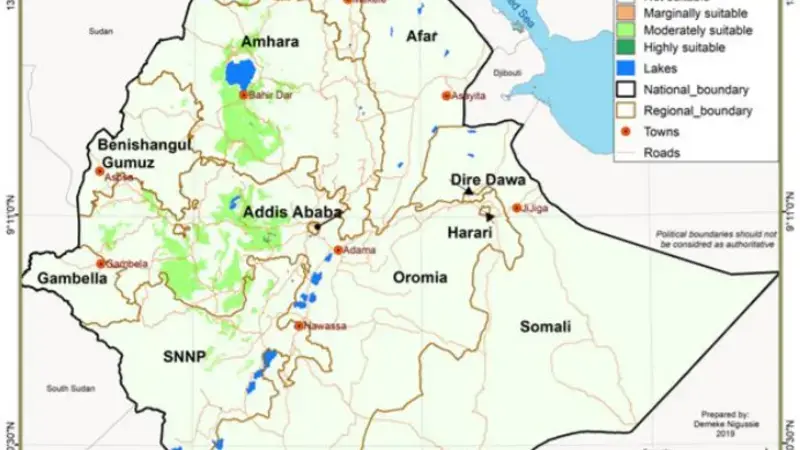Faba bean seed system landscape in the highlands of Ethiopia

Land suitability analysis is an evaluation and spatial decision making, involving several determining factors. The factors considered in this analysis include key biophysical parameters such as climate, topography, soil types and properties. The analysis was also focused on improved faba bean varieties viz., Dagm, Dosha, Gabelcho, Gora, Hachalu, Moti and Walki. This study is a national level and broad scale suitability analysis without considering irrigation potentials and socioeconomic aspects.
Scalable areas
The environmental factors’ layers of a specific crop pixel values were classified and given a weight, and then compared among themselves for further ranking to account for their relative importance to delineate variety specific extrapolation domains. The geo-statistical analysis was carried out to estimate the extent of the scalable areas.
The classification showed that, it was highly suitable for varieties 0.02 million hectares for Dosha; 0.19 for Gabelcho; 0.11 for Gora; 0.33 for Moti; 0.05 for Dagm; 0.14 for Hachalu; and 0.26 million hectares for Walki. Moderately suitable areas for these varieties covered 5.0, 9.4, 7.2, 15.3, 4.6, 8.8, and 7.5 million hectares, respectively across the country. The largest proportion for all varieties was moderately suitable; while the share of slightly suitable was very low, although there was quite variability within each of the faba bean variety in terms of its agro-ecology adaptation to the target environments. Such biophysical spatial frameworks become essential entry points for introducing variety specific product profiles and this can be further enhanced by incorporating socio-economic attributes accounting for return of the investment in targeting the technology.
Limitations
This study is a broad scale nationwide suitability analysis based on biophysical factors and intended to serve as a guide for agricultural research and development related policy and decision-making at national level. One of the constraints that limit the quality of these suitability analyses and mapping is the lack of fine resolution geospatial data to combine both biophysical and socioeconomic factors. The quality and scale of this work is dependent on the quality of geospatial data and information of environmental requirements of the different varieties included in this analysis. Hence, it should be noted that the outputs may not directly be used for applications that demand finer resolutions (e.g. at farm scale).
Further references:
- GIS-Based multi-criteria land suitability mapping for scaling faba bean varieties in Ethiopia - D Nigussie, W Mulugeta, A Molla, Z Bishaw, C Biradar - African Crop Science Journal, 2019
- Variety adoption and seed commercial behavior: Implications for the chickpea seed system in Ethiopia https://hdl.handle.net/20.500.11766/10385
- Varietal adoption and seed commercial behavior: Barley seed system landscape in the highlands of Ethiopia https://hdl.handle.net/20.500.11766/10386
